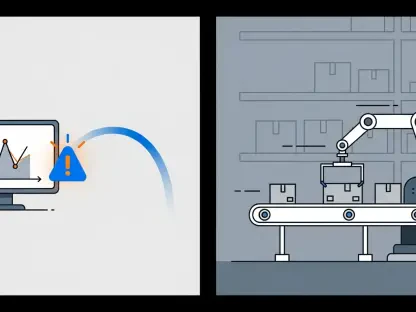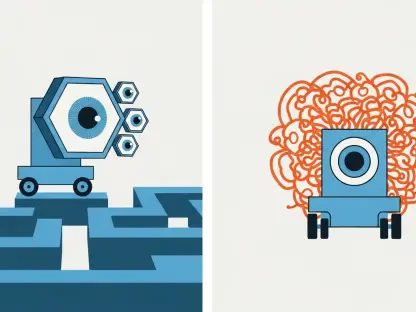In a world powered by cutting-edge technology, a hidden crisis looms over the very devices that define modern life, such as smartphones, electric vehicles, and wind turbines, all of which depend on rare earth elements—materials so critical yet so scarce that their supply has become a geopolitical battleground. With global demand soaring, industries face a stark reality: costs are skyrocketing, and environmental damage from mining is mounting. Could artificial intelligence offer a lifeline, revolutionizing the search for alternatives and breaking this dependency?
The stakes of this challenge extend far beyond mere economics. Rare earth elements are the backbone of permanent magnets, essential for technologies that drive sustainability and innovation. Without viable substitutes, the transition to green energy and affordable electric vehicles risks stalling. This exploration delves into a groundbreaking initiative at the University of New Hampshire (UNH), where AI is being harnessed to uncover new magnetic materials, potentially reshaping the future of tech industries.
Why Are Tech Industries Still Tied to Rare Earths?
Despite rapid advancements in technology, the reliance on rare earth elements remains a perplexing bottleneck. These materials, crucial for high-performance magnets, are integral to everything from medical imaging equipment to renewable energy systems. Although termed “rare,” many of these elements are not geologically scarce; rather, their extraction is complex, costly, and often controlled by a handful of nations, creating significant supply chain vulnerabilities for global markets.
This dependency poses a multifaceted problem for industries aiming to scale production. The fluctuating availability of rare earths directly impacts the cost of consumer goods, making cutting-edge technologies less accessible. Moreover, the geopolitical tensions surrounding their supply add an unpredictable layer of risk, pushing companies to seek innovative solutions to maintain competitiveness in a high-tech landscape.
The High Stakes of Rare Earth Reliance
The implications of rare earth dependency ripple through both economic and environmental spheres. Permanent magnets, which rely heavily on elements like neodymium and dysprosium, are vital for efficient electric motors and generators. As demand for electric vehicles and wind power surges, the pressure on limited rare earth supplies intensifies, driving up prices and threatening the affordability of sustainable technologies.
Beyond cost, the environmental toll of mining these materials cannot be overlooked. Extraction processes often result in toxic waste and habitat destruction, clashing with the very sustainability goals that rare earth-dependent technologies aim to achieve. Addressing this dilemma is not merely a technical hurdle but a pressing societal need, as industries grapple with balancing innovation against ecological responsibility.
AI’s Breakthrough in Magnetic Material Discovery
At the forefront of this challenge, a team at the University of New Hampshire has turned to AI to accelerate the discovery of alternative magnetic materials. By sifting through vast troves of scientific literature, their AI system has built the Northeast Materials Database, cataloging an impressive 67,573 magnetic compounds. Among these, 25 newly identified materials exhibit high-temperature magnetism, a property critical for practical applications in demanding environments.
Traditional methods of material discovery, often involving laborious and expensive lab testing, pale in comparison to this AI-driven approach. Where manual experimentation might take years to test thousands of combinations, AI processes millions of possibilities in a fraction of the time, pinpointing promising candidates for further study. This leap in efficiency marks a significant departure from conventional research constraints.
The potential real-world impact of these findings is substantial. Sustainable magnets derived from AI-identified materials could transform industries, particularly in electric vehicle manufacturing, where cheaper, rare earth-free batteries are a priority. With over 67,000 materials documented, this database stands as a testament to the transformative scope of AI, offering a tangible pathway toward reducing dependency on scarce resources.
Insights from Pioneers in Materials Science
The researchers behind this innovation express a palpable sense of optimism about AI’s role in materials science. Professor Jiadong Zang, a key figure in the UNH team, notes, “AI has the power to solve some of the toughest challenges in materials discovery, opening doors we couldn’t have imagined a decade ago,” as published in a recent Nature Communications study. His confidence underscores the potential for technology to redefine long-standing scientific barriers.
Lead author Suman Itani, a doctoral student in physics, highlights the collaborative nature of the project, blending expertise from physics and chemistry to fuel progress. Meanwhile, postdoctoral researcher Yibo Zhang has played a pivotal role in fine-tuning the AI models to ensure accuracy in identifying viable compounds. Their collective efforts reflect a broader consensus in the scientific community that AI is poised to revolutionize research methodologies.
To appreciate the magnitude of this shift, consider the grueling reality of pre-AI material testing, where scientists spent countless hours in labs, often yielding minimal results. One anecdote from a veteran researcher recalls years spent testing mere dozens of combinations with little success, a stark contrast to the speed and scale of today’s AI-driven discoveries. Such stories humanize the immense value of this technological advancement.
Practical Steps for Industries to Adopt AI Innovations
For tech industries eager to capitalize on these breakthroughs, actionable strategies are emerging to integrate AI-driven discoveries into real-world applications. A starting point lies in accessing the Northeast Materials Database, a searchable resource that allows companies to identify sustainable magnet alternatives tailored to specific needs. This tool offers a direct avenue for engineers to explore viable substitutes for rare earth-based components.
Collaboration stands as another critical pillar for progress. By fostering partnerships between AI specialists, materials scientists, and industry leaders, the transition from discovery to production can be accelerated. Such interdisciplinary efforts ensure that theoretical advancements translate into practical solutions, bridging the gap between lab and market.
Finally, prioritizing sustainability in product design is essential for long-term impact. Companies in sectors like renewable energy can leverage AI-identified materials to reduce both costs and environmental footprints. For instance, replacing rare earth magnets in wind turbine generators with sustainable alternatives could lower expenses while advancing green goals, demonstrating a clear step forward for industries ready to embrace change.
Reflecting on a Path Forward
Looking back, the journey of harnessing AI to tackle rare earth dependency marked a turning point for tech industries. The groundbreaking work at the University of New Hampshire, with its expansive database of over 67,000 magnetic materials, laid a foundation for sustainable innovation. It showcased how technology could address not just scientific challenges but also pressing economic and environmental concerns.
As industries moved forward from that pivotal moment, the focus shifted to scaling these discoveries into widespread adoption. Stakeholders were encouraged to invest in cross-sector collaborations and prioritize research into alternative materials between 2025 and 2027, ensuring that the momentum continued. Exploring funding for AI-driven projects emerged as a key next step to sustain progress.
Ultimately, the legacy of this research pointed toward a broader vision of resilience. By integrating these new materials into everyday technologies, companies had the chance to redefine supply chains and reduce geopolitical risks. This era of innovation offered a blueprint for future challenges, proving that with the right tools, even the most entrenched dependencies could be overcome.









